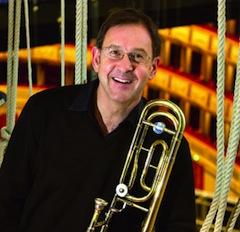Symphony Finale with Cinematic Gems
Into music, films, and film music? For someone passionate about all three, the San Francisco Symphony's summer series finale sounded irresistible.
"Music from the Movies" Friday night in Davies Hall, under the baton of Michael Francis, opened with Alfred Newman's 20th Century Fox fanfare. Francis beamed as he motioned the orchestra to take a bow after the 15-second flourish.
James Lipton, of the long-running television program Inside the Actors Studio, acted as MC, introducing the genre as "music to be felt, more than heard," something vital that should never be regarded as background or incidental music, never mind what Wiki says.
In a program of some of the biggest names in film scores, the opening work was the best "pure music," something forever linked with a film, but a great piece by itself. The Overture to The Sea Hawk, by Erich Korngold, has a handful of memorable themes, the second one utterly gorgeous, fully equivalent to anything in his youthful masterpiece, Die Tote Stadt. "Opera without singing," Lipton said.
The main title from Bernard Herrmann's score for North by Northwest, an "orchestral fandango," sounded more noisy than was necessary. The Overture to Maurice Jarre's Lawrence of Arabia score ranged — in composition and performance — from monumental to wonderfully vulgar.
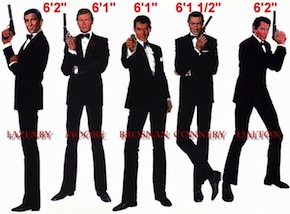
Although the composer for 11 James Bond films was John Barry, the original Bond theme, running through all the opening gun-barrel sequences, came from Monty Norman, now 83, a London jazz singer and big-band composer. Norman won several libel suits against publishers claiming that Barry — who did the orchestration — was the composer. In Davies Hall, the piece was properly credited to Norman.
Lipton introduced the “Love Theme” from Nino Rota's score for The Godfather by quoting director Francis Ford Coppola to the effect that Paramount studio boss Robert Evans hated the score and demanded that it be replaced. Coppola told Evans that he'd quit if that were to happen. After a stalemate, "Coppola waited for Evans at his tennis court — this is Hollywood, after all — and proposed a test screening of the film with Rota's music," Lipton said, and Coppola eventually won the argument.

The music is fine, no doubt about it, and Evans was dead wrong, but of Rota's more than 150 film scores (he was a virtual house composer for such giants of cinema as Fellini, Visconti, and Zeffirelli, among many others), it is perhaps not among his best.
The late Michael Kamen — whose San Francisco Symphony/Metallica concert was recorded in Berkeley as the S&M Live Album — was represented by the Overture to Robin Hood, Prince of Thieves.
Hallowed is the name of Danny Elfman for Simpsons and Batman fans, but beyond those snappy themes, he wrote many full, rich scores, including the one for Spiderman , whose main theme was on the SFS program.
Excerpts from John Williams’ film scores took up the second half of the concert, consisting of main themes from Jurassic Park, Schindler's List, the Harry Potter films, and — of course — E.T. Major film composers who couldn't be squeezed into this program could fill dozens of concerts; I hope planning starts soon for Max Steiner, Franz Waxman, Miklós Rózsa, Robert Russell Bennett, Dimitri Tiomkin, A.R. Rahman ...
New Opera in Context
Awaiting the premiere of Christopher Theofanidis' Heart of a Soldier in the War Memorial Opera House on Sept. 10, here's some background material of San Francisco Opera world premieres in recent years: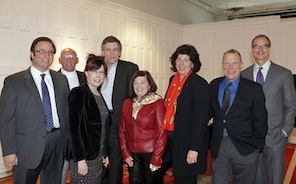
1961 Dello Joio, Blood Moon
1976 Imbrie, Angle of Repose
1976 Ives, Meeting Mr. Ives [Opera Center]
1980 Mechem, Tartuffe [Opera Center]
1982 Fine, The Women in the Garden [Opera Center]
1982 Harbison, Full Moon in March [Opera Center]
1994 Susa/Littell, The Dangerous Liaisons
1998 Previn/Littell, A Streetcar Named Desire
2000 Heggie/McNally, Dead Man Walking
2001 Chukhadjian/Tersian, Arshak II (in the dispute over whether this was a world premiere, I say yes)
2005 Adams/Sellars, Doctor Atomic
2007 Pasatieri, The Hotel Casablanca [Merola Opera Program]
2007 Glass/Hampton, Appomattox
2008 Wallace/Tan, The Bonesetter's Daughter
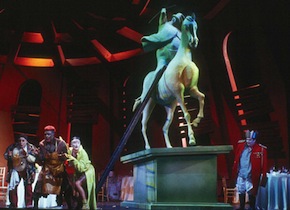
Going back longer, here are S.F. Opera’s U.S. premieres:
1930 Ravel/Colette, L'Enfant et les Sortileges
1954 Cherubini/Confalonieri, L'Hotellerie Portugaise
1954 Honegger, Jeanne d'Arc au Bucher (first staged in S.F.)
1955 Walton/Hassell, Troilus and Cressida
1957 Poulenc/Bernanos, Dialogues des Carmelites
1958 Cherubini/Hoffman, Médée (first staged in S.F.)
1958 Orff, Die Kluge
1958 Cherubini/Hoffman, Médée (first staged in S.F.)
1958 Orff, Carmina Burana (first staged in S.F.)
1959 Strauss/Hofmannsthal, Die Frau ohne Schatten
1961 Britten/Pears, A Midsummer Night's Dream
1964 Shostakovich/Preis, Katerina Ismailova
1966 Janáček, Makropulos Case
1966 Berlioz, Les Troyens (first staged in S.F.)
1967 Schuller, The Visitation
1968 Weill/Goll, Royal Palace
1968 Milhaud/Claudel, Christopher Columbus (first staged in S.F.)
1971 Donizetti/Bardari, Maria Stuarda (first staged in S.F.)
1972 Von Einem/Durrenmatt, The Visit of the Old Lady
1977 Ullman/Kien, Der Kaiser von Atlantis [Spring Opera Theater]
1979 Harbison, A Winter's Tale [Opera Center] (first staged in S.F.)
1981 Reimann/Henneberg, Lear
1983 Tippett, The Midsummer Marriage
1985 Hindemith, The Long Christmas Dinner [Opera Center]
1988 Rossini/Della Valle, Maometto II
1988 Titus, Rosina [Opera Center]
1989 Handel, Giustino [Opera Center]
1990 Reimann, The Ghost Sonata [Opera Center]
1991 Henze/Treichel, Das Verratene Meer
1992 Rossini/Tottola, Ermione (first staged in S.F.)
2002 Messiaen, Saint François d'Assise
2004 Ligeti/Meschke, Le grand Macabre
A Musician's Life
The real-life minutiae of a musician's life can be found in a blog by Ian Bousfield, principal trombone of the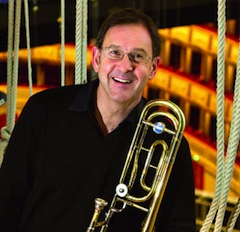
What with my commitments with the Vienna Philharmonic, Vienna State Opera, Vienna Hofkapelle Orchestra, my many master classes and solo playing, I don’t get the chance to breathe out very often.With my new appointment as Professor at the Hochschule der Künste Bern, things, for the time being, are not about to get much more relaxed either. The older I get, the less I can sleep in like I used to. Even if I get back from an opera at 11:30 p.m., I still don’t sleep much past 7:00 a.m. now.
So, the day starts invariably with one or two coffees made by my beloved Pavoni espresso machine, and often includes the ceremony of me hand-grinding the coffee to start with.
After a leisurely breakfast, I usually try and catch up on a few emails, then have a warm-up for 30–40 minutes. I live in a cyclist’s paradise in the Vienna Woods and have been bitten by the bug myself, so if it’s a nice day, I get on my racing bike (which is far too good for me) and beat myself around the local villages for up to 1.5 hours.
As I have to organize all of my travel myself, a free day also usually involves making sure flights are booked and hotels and hire cars are organized. In March of this year I did a once-around-the-world trip on my own, and the organization for that was rather hair-raising. It's so much easier when you just hand yourself over, sheeplike, to an orchestral organization team.
I am a very incentive-based practicer; because I've worked so hard over the years, I tend not to do any more practice than I absolutely have to. The benefit of experience helps me to calculate pretty much how to prepare for whatever is coming up as economically as possible.
I tend not to take days off practicing, but sometimes I will only do the 30–40 minute session in the morning. When you work as hard as I do, it's important to rest the muscles sometimes, as well. So, the afternoon practice session could be anything up to two hours if I've got something tough to play.
Hart Takes on the Universe
Mickey Hart, former drummer for the Grateful Dead and a multitalented author/composer/musician, is preparing a new album in Sebastopol and going on a tour with several Bay Area stops. The yet-unnamed album aims to "set the sounds of the entire history of the universe to music."Hart, 67, is a board member of the Smithsonian, and his collaborators on the project include NASA scientists, engineers at Meyer Sound, and telescope operators around the globe. The basis of the work is light waves transferred to sound waves.
"I've been involved in sampling the epic events of the universe from the Big Bang to now, everything that makes up our lives. It's all about the vibrations of life. In this case they began as light waves, and these light waves are still washing over us. ... I want to bring these light waves into the human range and use that as a musical catalyst and play with it," Hart told The San Francisco Chronicle.
"The cosmic low end of the universe is a B-flat. That's one of my key sounds. I couldn't do this work without the beginning of the story. It's just beginning. The universe is infinite. Now I just need another 20 years."
The Mickey Hart Band plays at the Napa Valley Opera House on Aug. 5 and at the Independent in San Francisco on Aug. 6, before heading east.
Girls Chorus Director to Leave
Much to her and her chorus' surprise, San Francisco Girls Chorus Artistic Director Susan McMane was notified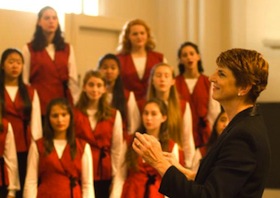 that her contract will not be renewed at the end of March, bringing her decade-long tenure to an end.
that her contract will not be renewed at the end of March, bringing her decade-long tenure to an end.
The organization's current and past presidents, Kerry King and Dorian Kingman Chong, notified chorus members and their families by e-mail last week about "taking the Chorus in a new direction." There was no press announcement.
Chorus members have gone on Facebook, Tweet, and tumblr.com to protest the decision. Kingman Chong said she understands the response: "This always happens when there's a transition. There's an emotional tidal wave, and then we go forward and that wave turns into something positive."
McMane, 62, joined the chorus in 2001, succeeding Sharon J. Paul and founder Elizabeth Appling as the group's third artistic director. She said she was surprised by the decision: "They said I'd done a wonderful job, but they just wanted a new direction. I don't know what the new direction is."
Kingman Chong, who appears to be the spokesperson for the administration, followed up with an e-mail to chorus members and families on July 29, including the following points:
The mission of the San Francisco Girls Chorus remains unchanged ... to create outstanding performances featuring the unique and compelling sound of young women’s voices through an exemplary music education program.There has been no discussion or intention to dilute, "dumb down" or otherwise compromise our programs and high standards of musical and educational excellence.
This transition will not alter the structure, standards or programs of the Chorus School.
Our new direction will be one in which we build upon a substantial and solid foundation to realize our strategic goals, which include: continuing growth of Chorissima, our performing arm, as a musical organization and expansion of our audiences beyond choral music attendees.
The timing of the decision and its announcement were not arbitrary but dictated by the terms of Susan's contract. Susan was not fired. Her contract is coming to its natural close. Susan made the decision to take a sabbatical which is due to her under the terms of the contract from April–June 2012 with her last performance in March.
We are not withholding information about the future. We are in the early stages of planning, and decisions will be communicated in a timely way.
On a personal note, I want to say that I am an alum parent with a 30-year commitment to the Chorus. I and other Board members with similarly long associations with the Chorus are personally dedicated to the high standard of excellence and core mission of SFGC.
San Francisco Opera Orchestra Contract Ratified
Details of the agreement between the San Francisco Opera Association and the American Federation of Musicians Local 6 were announced yesterday.The three-year labor contract (which follows a five-year agreement) includes an increase in the weekly rate of pay, and employment of 28 weeks a year (including paid vacation) for the 69 members of the Opera Orchestra in exchange for "contractual changes that provide the Opera Association both current savings and new flexibility in reducing expenses." At the end of the last contract (expiring July 31), the 24-week basic compensation was approximately $80,000.
Local 6's international parent union, the American Federation of Musicians, joined San Francisco Opera in announcing the conclusion of a separate, new Integrated Media Agreement that covers the creation and distribution of audio and audiovisual media. Both contracts were ratified by orchestra members on July 22, after three months of negotiations.
Rate increases are 2 percent in the first year and 3 percent in the last two years of the agreement, and an increase in the Electronic Media Guarantee from $2,375 in the expiring Agreement to $5,000 by 2013, while providing more than $1 million in savings each year to the San Francisco Opera through changes to compensation and healthcare structures.
Both parties, according to the announcement, "kept in mind the financial constraints of San Francisco Opera, which has faced deficits in the last two seasons. The new agreement is a major step towards attaining a more stable fiscal operating model for the company."
Mike Richter Online Again
Readers of Music News have been reading for years about the selfless exploits of Mike Richter, retired NASA engineer and creator of nonprofit projects to save and distribute classic opera performances.If you check ImageMogul, one of the distributors for Richter's CD-ROMs, such as all operas of Wagner, Richard Strauss, and others on a single disc each, you will see that nothing is priced above $10. That restriction was the author's mandate, even though his own expenses far exceeded the cost.
Take a look at his recordings of Sir Thomas Beecham performances to see the depth of "Richter Discs."
A year and a half ago, Richter — on disability with heart problems for decades — suffered a debilitating stroke. After an operation and months of intense therapy, he is still having problems typing (he is using a computer program to help with typing) and he has not yet fully recovered his skills to resume his work.
And yet, he asks for his e-mail address — mrichter39@yahoo.com — to be made public, saying he would enjoy hearing from old friends and new ones too. He will try to read the mail, Mike said, "with the understanding that a failure to respond would reflect only my limitations, not a lack of interest."
A tip to collectors of "Richter CD-ROMs": Margo Briessinck has provided downloadable and printable covers and tables of content online for the discs.
Unexpected GOP Support in Congress for the NEA
An amendment to a National Endowment for the Arts appropriation offered by Rep. Tim Walberg (R-MI) would have decreased Fiscal Year 2012 funding to $124.4 million, but was defeated by a vote of 181–240, with 55 Republicans voting in opposition to the amendment.Five months ago, when Rep. Walberg offered an amendment to decrease the current FY11 funding of the NEA to $124.4 million, the amendment passed in the House by a vote of 217–209. The ultimate FY11 bill approved by Congress, however, contained $155 million for the NEA.
The Big One Is a Page-Turner, Ground-Shaker
"Dmitri Hvorostovsky and René Pape were both good-looking, broad-shouldered men over six feet tall. ... Leporello slipped on his boss' Armani suit. ... his black knit cap was pulled down to cover Giovanni's silver-gray hair. ...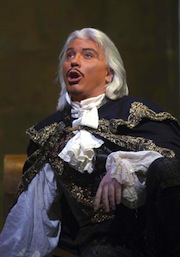
"Once crumpled to the ground and crying out in pain, Masetto is smacked about the head and body with the butt of his own rifle. ... Catherine had put her right hand over her eyes in order to listen to the singing without having to look at the nonsense onstage. ...
"The noise that suddenly engulfed them [in the War Memorial] was like that of a hundred high ocean waves breaking at once. ... the house was visibly swaying and jerking, shedding chunks of itself onto the audience, its steelwork crying out under the strain."
So much for the $90 million seismic reconstruction when the next Big One comes.
Disasters have a way of concentrating the mind and revealing unknown or unrealized truths.
So it was at the collapse of a Peruvian suspension bridge in Thornton Wilder's Bridge of San Luis Rey, and so it is in the San Francisco story of David Littlejohn's novel The Big One: A Story of San Francisco.
Wilder's people came to the bridge connected through a variety of relationships, just as Littlejohn's characters do with the ground convulsing beneath them.
Which Big One? Not 1906, not 1989, but the next big one. The time is close enough so that many references in the novel to events and public figures are well at home in today's newspapers. Indeed, the name-dropping is so hot and heavy, an index would be helpful for checking out where you are mentioned.
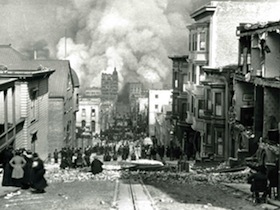
In Peru and here, problems and crises are resolved tragically, but effectively, under collapsing bridges both there and here.
Similar, too, is the fluency of writing by the two authors — these are books "hard to put down." I read The Big One during a very busy time, then struggled to pick it up again, but each time I read a portion it was hard to stop reading.
The variety of Littlejohn's characters is dazzling: a troubled captain of industry, about to be hoisted on the petard of profitable — if illegal — business deals; a black mother–daughter duo struggling in the new low-cost housing project of Willie Brown Town; a (moderately) reform-minded mayor; a mismatched but tenacious gay couple; a strange artist slipping in and out of paranoid schizophrenia; and many others.
We stay with them through rumblings of the Earth, shudders in their lives, through Eurotrash opera, both in luxurious and rundown environments, as they, along with the reader, are heading for the Big One.
For San Franciscans, past and present, minute descriptions of settings (not just street by street, but block by block, building by building) may make for especially interesting reading. For others, the detailed physical inventories could be a tad too much; going from the Marina to City Hall, for example, would take less time to drive than reading about it.
But when it comes to characters and situations, Littlejohn's attention to detail is welcome for all: It's what is known as a "good read."
As the characters converge at a reception before their fatal Don Giovanni in the War Memorial, for example: "By the crème brûlée and coffee — they always had Patty's crème brûlée, a cup of sweet ivory-colored cream covered with a think caramel glaze — Wendy's brutal brats, Fred's self-destructive drinking and whatever Jake may or may not have done to Byrne and Bertetta had vanished into the aromatic, alcoholic air. ... they felt ready for three hours of Mozart."
And then, inside the Opera House, mentioning the current management, but with the production harkening back to the previous one:
"After David Gockley's recorded welcome and turn-off-your-pagers-and-cell-phones warning, the conductor — Donald, now Sir Donald Runnicles — did his breast-stroke through the orchestra, mounted the podium, and faced the house to receive his ritual applause, nodding his gray curls. ... [On the stage] two men wearing black got out of opposite sides of the red sports car.
"Moving to the music like a dancer, a handsome fellow with long silvery hair began taking off his clothes. One by one he tossed them, on the first beat of a bar, to the other man, who snatched them in the air, folded them, and laid them in the car." And soon the X-rated production unfolds.
Ah, Mozart! And then parts of the maximally reinforced Opera House pancake, and those fleeing through the Grove Street doors find Franklin Street "split by a fissure at least a foot wide. ..."

